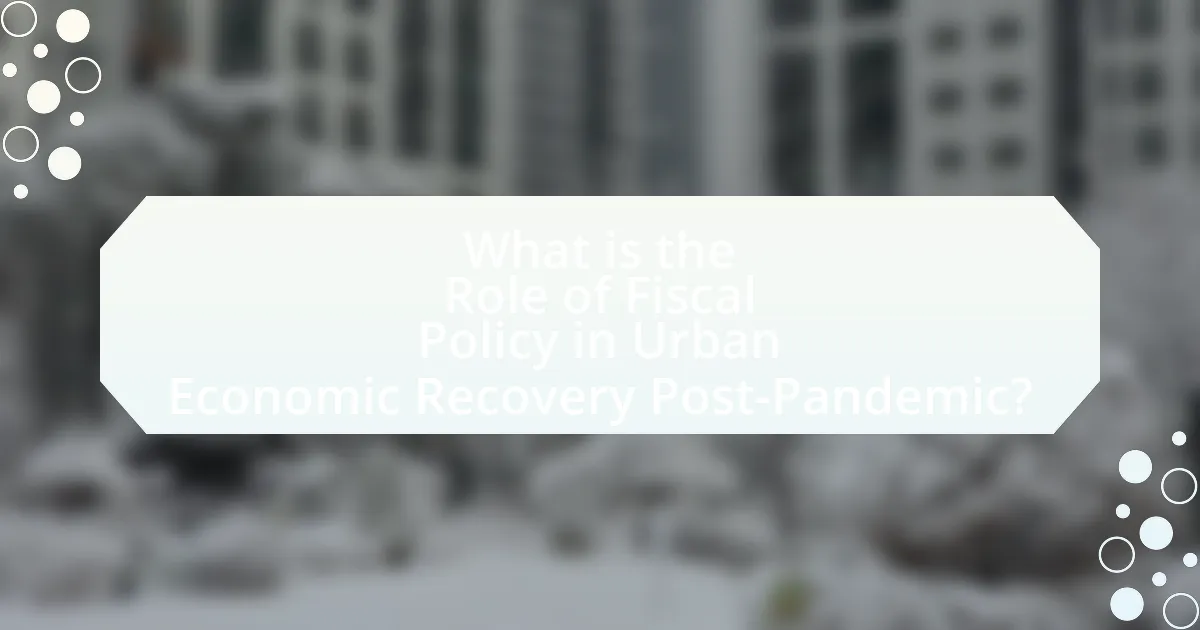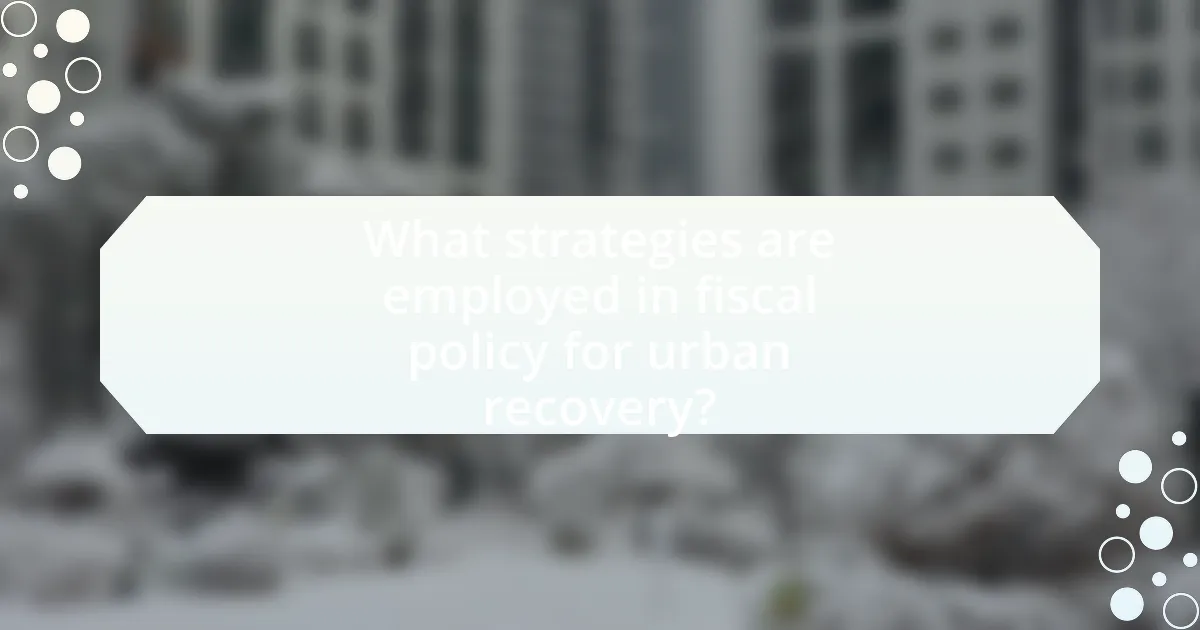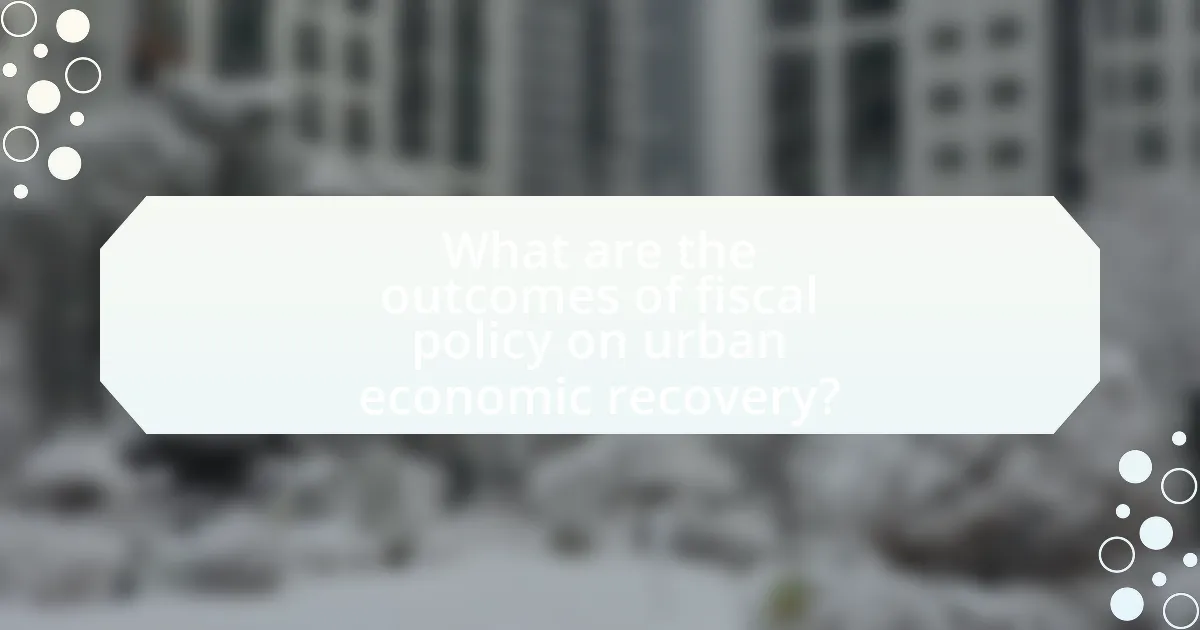Fiscal policy is a critical tool for urban economic recovery in the aftermath of the pandemic, providing essential financial support to stimulate growth and stabilize local economies. The article examines how targeted government spending, taxation adjustments, and financial assistance programs can revitalize urban areas by creating jobs, enhancing infrastructure, and addressing inequalities exacerbated by the pandemic. Key components of effective fiscal policy include public investment in essential services, tax incentives for businesses, and strategic partnerships among government agencies and community organizations. The discussion highlights the importance of tailored fiscal strategies to meet specific urban needs and the role of stakeholder engagement in improving policy outcomes.

What is the Role of Fiscal Policy in Urban Economic Recovery Post-Pandemic?
Fiscal policy plays a crucial role in urban economic recovery post-pandemic by providing targeted financial support to stimulate growth and stabilize local economies. Governments can implement measures such as increased public spending on infrastructure, direct financial assistance to individuals and businesses, and tax relief to boost consumer spending and investment. For instance, the American Rescue Plan Act of 2021 allocated $350 billion to state and local governments, enabling them to address budget shortfalls and invest in essential services, which is vital for revitalizing urban areas affected by the pandemic. This strategic use of fiscal policy not only helps to mitigate the immediate economic impacts but also lays the groundwork for long-term recovery and resilience in urban settings.
How does fiscal policy influence urban economies during recovery phases?
Fiscal policy significantly influences urban economies during recovery phases by directing government spending and taxation to stimulate economic activity. For instance, increased public investment in infrastructure can create jobs, enhance local services, and attract private investment, thereby revitalizing urban areas. Historical data from the 2008 financial crisis shows that cities implementing aggressive fiscal stimulus measures, such as the American Recovery and Reinvestment Act, experienced faster economic rebounds compared to those that did not. Additionally, targeted tax relief for businesses and households can boost consumer spending, further driving economic recovery in urban settings.
What are the key components of fiscal policy relevant to urban recovery?
The key components of fiscal policy relevant to urban recovery include government spending, taxation, and financial assistance programs. Government spending focuses on infrastructure development, public services, and community projects that stimulate local economies. For instance, the American Rescue Plan Act allocated $350 billion to state and local governments to support recovery efforts. Taxation policies can be adjusted to provide relief to businesses and individuals, encouraging spending and investment. Additionally, financial assistance programs, such as grants and low-interest loans, are crucial for supporting small businesses and vulnerable populations during recovery phases. These components collectively aim to revitalize urban areas by enhancing economic stability and promoting growth.
How do government spending and taxation affect urban economic revitalization?
Government spending and taxation significantly influence urban economic revitalization by directing resources into infrastructure, services, and incentives that stimulate local economies. Increased government spending on public projects, such as transportation and housing, creates jobs and attracts private investment, which can lead to a revitalized urban environment. For instance, the American Recovery and Reinvestment Act of 2009 allocated $787 billion to stimulate the economy, resulting in job creation and infrastructure improvements in urban areas. Conversely, taxation policies can either encourage or deter investment; lower taxes on businesses can incentivize growth and development, while higher taxes may limit disposable income and investment potential. Research indicates that cities with favorable tax environments often experience faster economic recovery and growth, as seen in the post-pandemic recovery efforts in various metropolitan areas.
Why is fiscal policy critical for urban areas recovering from the pandemic?
Fiscal policy is critical for urban areas recovering from the pandemic because it provides essential funding for public services, infrastructure, and economic stimulus. Urban areas, which often faced significant economic downturns and increased demand for social services during the pandemic, rely on fiscal policy to allocate resources effectively. For instance, the American Rescue Plan Act of 2021 allocated $350 billion to state and local governments, enabling them to support public health initiatives, maintain essential services, and invest in infrastructure projects. This financial support is vital for revitalizing local economies, creating jobs, and ensuring that urban areas can recover and thrive in the post-pandemic landscape.
What challenges do urban economies face without effective fiscal policy?
Urban economies face significant challenges without effective fiscal policy, including increased unemployment, reduced public services, and diminished investment in infrastructure. Ineffective fiscal policy can lead to budget deficits, which restrict local governments’ ability to fund essential services such as education, healthcare, and public safety. For instance, during the COVID-19 pandemic, cities that lacked robust fiscal measures experienced a 10% average increase in unemployment rates, exacerbating economic instability. Additionally, without strategic fiscal interventions, urban areas may struggle to attract private investment, leading to stagnation in economic growth and innovation. This lack of investment can result in deteriorating infrastructure, further hindering economic recovery and quality of life for residents.
How can fiscal policy address inequalities exacerbated by the pandemic?
Fiscal policy can address inequalities exacerbated by the pandemic through targeted government spending and progressive taxation. By increasing funding for social programs such as unemployment benefits, healthcare, and education, fiscal policy can directly support vulnerable populations disproportionately affected by the pandemic. For instance, the U.S. government allocated over $2 trillion in relief through the CARES Act, which provided direct payments and enhanced unemployment benefits, helping to alleviate financial strain on low-income households. Additionally, implementing a progressive tax system can ensure that wealthier individuals contribute a fairer share, allowing for increased investment in public services that benefit disadvantaged communities. This approach not only mitigates immediate economic disparities but also fosters long-term equitable growth by investing in human capital and infrastructure in underserved areas.

What strategies are employed in fiscal policy for urban recovery?
Fiscal policy strategies for urban recovery include targeted public spending, tax incentives, and infrastructure investment. Targeted public spending focuses on essential services such as healthcare, education, and housing to stimulate local economies and support vulnerable populations. Tax incentives, such as property tax abatements or sales tax reductions, encourage business investment and job creation in urban areas. Infrastructure investment, particularly in transportation and digital connectivity, enhances economic productivity and attracts private investment. These strategies are supported by evidence showing that cities implementing such fiscal policies have experienced faster economic recovery and improved quality of life post-pandemic. For instance, the American Rescue Plan Act allocated $350 billion to state and local governments, enabling them to fund these recovery initiatives effectively.
How do stimulus packages impact urban economic recovery?
Stimulus packages significantly enhance urban economic recovery by injecting immediate financial resources into local economies. These packages typically provide funding for infrastructure projects, support for small businesses, and direct financial assistance to residents, which collectively stimulate job creation and consumer spending. For instance, the American Rescue Plan Act of 2021 allocated $350 billion to state and local governments, enabling them to address budget shortfalls and invest in community services. This influx of capital can lead to increased economic activity, as seen in cities that utilized stimulus funds to revitalize public spaces and improve transportation systems, ultimately fostering a more resilient urban economy.
What types of projects are prioritized in urban stimulus initiatives?
Urban stimulus initiatives prioritize infrastructure projects, affordable housing developments, and public health improvements. These projects are essential for revitalizing urban areas, addressing immediate community needs, and fostering long-term economic growth. For instance, the American Rescue Plan Act of 2021 allocated significant funding for infrastructure improvements, which are crucial for enhancing transportation systems and creating jobs. Additionally, investments in affordable housing aim to reduce homelessness and improve living conditions, while public health projects focus on enhancing healthcare access and pandemic preparedness.
How is funding allocated to ensure equitable recovery across urban sectors?
Funding is allocated to ensure equitable recovery across urban sectors through targeted fiscal policies that prioritize vulnerable communities and sectors most affected by economic disruptions. This allocation often involves the distribution of federal and state resources, such as grants and loans, specifically designed to support small businesses, affordable housing, and public health initiatives. For instance, the American Rescue Plan Act of 2021 allocated $350 billion to state and local governments, enabling them to invest in infrastructure, public services, and economic recovery programs that address disparities exacerbated by the pandemic. Additionally, funding mechanisms may include community engagement processes to identify local needs, ensuring that resources are directed where they are most needed, thereby promoting equity in recovery efforts.
What role do local governments play in implementing fiscal policy?
Local governments play a crucial role in implementing fiscal policy by managing local budgets, setting tax rates, and allocating resources to public services and infrastructure. They influence economic recovery through targeted spending initiatives, such as funding for public health, education, and transportation projects, which stimulate local economies. For instance, during the COVID-19 pandemic, many local governments utilized federal relief funds to support small businesses and provide unemployment assistance, directly impacting economic stability and growth in their communities. This demonstrates that local governments are essential in translating broader fiscal policies into actionable programs that address specific local needs and conditions.
How can local governments tailor fiscal policies to meet specific urban needs?
Local governments can tailor fiscal policies to meet specific urban needs by conducting comprehensive assessments of local demographics, economic conditions, and community priorities. This approach allows them to allocate resources effectively, ensuring that funding addresses the most pressing issues such as housing, transportation, and public health. For instance, cities like San Francisco have implemented targeted tax incentives to stimulate affordable housing development, responding directly to the urban need for increased housing availability. Additionally, local governments can utilize data analytics to monitor the impact of fiscal policies in real-time, adjusting strategies as necessary to optimize outcomes. This evidence-based approach ensures that fiscal policies remain relevant and effective in addressing the unique challenges faced by urban populations, particularly in the context of recovery from the pandemic.
What partnerships are essential for effective fiscal policy execution?
Effective fiscal policy execution requires partnerships between government agencies, financial institutions, and community organizations. Government agencies provide the regulatory framework and funding necessary for fiscal initiatives, while financial institutions offer expertise in managing resources and investments. Community organizations play a crucial role in ensuring that fiscal policies address the needs of local populations, facilitating outreach and implementation. For instance, during the COVID-19 pandemic, collaboration between these entities enabled the swift distribution of relief funds, demonstrating the importance of coordinated efforts in achieving fiscal objectives.

What are the outcomes of fiscal policy on urban economic recovery?
Fiscal policy significantly influences urban economic recovery by stimulating demand, creating jobs, and enhancing public services. For instance, targeted government spending on infrastructure projects can lead to immediate job creation and long-term economic benefits, as seen in the American Recovery and Reinvestment Act of 2009, which allocated $787 billion to boost the economy post-recession. Additionally, fiscal measures such as tax incentives for businesses can encourage investment in urban areas, further driving economic growth. Research indicates that cities implementing robust fiscal policies during economic downturns experience faster recovery rates, as evidenced by studies from the National Bureau of Economic Research, which highlight the correlation between fiscal stimulus and urban revitalization.
How does fiscal policy contribute to job creation in urban areas?
Fiscal policy contributes to job creation in urban areas by increasing government spending and adjusting tax policies to stimulate economic activity. For instance, targeted investments in infrastructure projects can create immediate job opportunities in construction and related sectors, while tax incentives for businesses can encourage hiring and expansion. According to the Congressional Budget Office, every $1 billion in federal spending can create approximately 13,000 to 15,000 jobs, demonstrating the direct impact of fiscal measures on employment levels. Additionally, fiscal policies that support education and workforce development programs can enhance the skills of the urban workforce, further promoting job creation in diverse industries.
What sectors benefit most from fiscal interventions in urban recovery?
The sectors that benefit most from fiscal interventions in urban recovery are housing, transportation, and small businesses. Housing initiatives, such as subsidies and tax incentives, stimulate construction and affordability, which is crucial for urban revitalization. Transportation investments enhance connectivity and accessibility, promoting economic activity and reducing congestion. Small businesses receive targeted support through grants and loans, fostering job creation and local economic resilience. According to the Urban Institute, targeted fiscal policies in these sectors can lead to significant improvements in urban recovery outcomes, demonstrating their critical role in revitalizing post-pandemic economies.
How can fiscal policy stimulate long-term economic growth in cities?
Fiscal policy can stimulate long-term economic growth in cities by increasing public investment in infrastructure, education, and healthcare. These investments enhance productivity and create jobs, which in turn boosts local economies. For instance, a study by the National Bureau of Economic Research found that every dollar spent on infrastructure can generate up to $2.50 in economic output over time. Additionally, targeted tax incentives can attract businesses and encourage innovation, further driving growth. Historical examples, such as the post-World War II economic expansion in the United States, demonstrate how strategic fiscal policies can lead to sustained urban development and prosperity.
What metrics are used to evaluate the success of fiscal policy in urban recovery?
Metrics used to evaluate the success of fiscal policy in urban recovery include employment rates, GDP growth, tax revenue changes, and public investment levels. Employment rates indicate the effectiveness of fiscal measures in creating jobs, while GDP growth reflects overall economic health and recovery. Changes in tax revenue demonstrate the fiscal policy’s impact on economic activity, and public investment levels assess the extent of government spending in infrastructure and services that stimulate urban recovery. These metrics provide a comprehensive view of how fiscal policies contribute to revitalizing urban economies post-pandemic.
How do we measure the impact of fiscal policy on urban employment rates?
The impact of fiscal policy on urban employment rates is measured through various economic indicators and statistical analyses. Researchers often utilize data on employment rates, wage levels, and job creation metrics before and after the implementation of fiscal policies, such as government spending or tax changes. For instance, studies have shown that targeted fiscal stimulus can lead to significant increases in urban employment; a notable example is the American Recovery and Reinvestment Act of 2009, which resulted in an estimated 2.5 million jobs created or saved, according to the Congressional Budget Office. Additionally, econometric models are employed to isolate the effects of fiscal policy from other economic factors, allowing for a clearer understanding of its direct impact on urban employment.
What indicators reflect improvements in urban infrastructure due to fiscal policy?
Indicators that reflect improvements in urban infrastructure due to fiscal policy include increased public investment in transportation, enhanced utility services, and improved public spaces. For instance, cities that allocate a higher percentage of their budgets to infrastructure projects often report better road conditions, reduced traffic congestion, and upgraded public transit systems. According to the American Society of Civil Engineers, cities that invested significantly in infrastructure saw a 10% increase in overall economic productivity. Additionally, metrics such as the number of completed infrastructure projects, improvements in service delivery times, and enhanced accessibility for residents serve as concrete evidence of fiscal policy effectiveness in urban infrastructure development.
What best practices can enhance the effectiveness of fiscal policy in urban recovery?
Best practices that can enhance the effectiveness of fiscal policy in urban recovery include targeted investment in infrastructure, support for small businesses, and the implementation of progressive taxation. Targeted investment in infrastructure, such as public transportation and green spaces, can stimulate job creation and improve urban livability, as evidenced by studies showing that every $1 billion invested in infrastructure generates approximately 13,000 jobs. Supporting small businesses through grants and low-interest loans can help revitalize local economies, with research indicating that small businesses account for 64% of new jobs created in the U.S. Lastly, implementing progressive taxation can ensure that wealthier individuals contribute a fair share, providing necessary funding for social programs that support vulnerable populations during recovery. These practices collectively create a robust framework for effective fiscal policy in urban recovery.
How can stakeholder engagement improve fiscal policy outcomes?
Stakeholder engagement can improve fiscal policy outcomes by ensuring that diverse perspectives and needs are considered in the decision-making process. When stakeholders, including community members, businesses, and local organizations, actively participate in fiscal policy discussions, the resulting policies are more likely to address the specific economic challenges faced by urban areas, particularly in the context of post-pandemic recovery. For instance, research by the International Monetary Fund indicates that inclusive stakeholder engagement leads to better policy design and implementation, as it fosters transparency and accountability, ultimately enhancing public trust and compliance. This collaborative approach can result in more effective allocation of resources, tailored interventions, and increased economic resilience in urban settings.
What lessons have been learned from previous fiscal policy implementations in urban settings?
Previous fiscal policy implementations in urban settings have demonstrated the importance of targeted interventions to address specific local needs. For instance, cities that invested in infrastructure improvements saw a direct correlation with job creation and economic revitalization, as evidenced by the American Recovery and Reinvestment Act of 2009, which allocated funds for urban infrastructure projects and resulted in significant employment boosts in affected areas. Additionally, the effectiveness of fiscal policies is enhanced when they incorporate community input, as seen in various participatory budgeting initiatives that led to more equitable resource distribution and increased public trust. These lessons underscore the necessity of adaptability and responsiveness in fiscal policy to effectively support urban economic recovery.

Leave a Reply